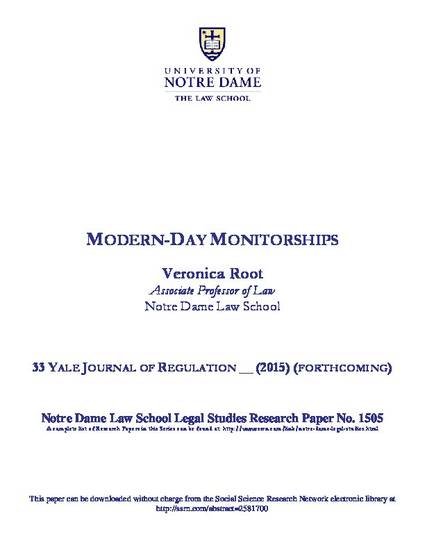
- Law and
- Privacy Law
When a sexual abuse scandal rocked Penn State, when Apple engaged in anticompetitive behavior, and when servicers like Bank of America improperly foreclosed upon hundreds of thousands of homeowners, each organization entered into a Modern-Day Monitorship. Modern-Day Monitorships are utilized in an array of contexts to assist in widely varying remediation efforts. They provide outsiders a unique source of information about the efficacy of the tarnished organization’s efforts to remediate misconduct. Yet despite their use in high-profile and serious matters of organizational wrongdoing, they are not an outgrowth of careful study and deliberate planning. Instead, Modern-Day Monitorships have been employed in an ad-hoc and reactionary manner, which has resulted in repeated instances of controversy and calls for reform by scholars and legislators. Accompanying these calls for reform has been an implicit assumption that all monitorships are made equal; that broad-based rules could effectively regulate all monitorships.
Yet, when tested, this assumption is found lacking. This Article traces the rise of the Modern-Day Monitorship and, for the first time, analyzes the use of monitorships in five different contexts. The analysis demonstrates that Modern-Day Monitorships have experienced a rapid evolution with important consequences. First, as demonstrated by the Apple monitorship, the evolution has changed the manner in which courts and lawyers conceive of the appropriate boundaries and norms for court-ordered monitorships. Second, as demonstrated by the Penn State scandal, private organizations are coopting the use of monitorships, which may be transforming the nature of monitorships from one of a quasi-government enforcement mechanism to what looks like a privatized tool of reputation remediation. Third, monitorships fall into different categories based on the type of remediation effort the monitorship is meant to achieve. Because these different categories necessitate different monitorship structures, attempts to adopt universal rules governing monitorships may be misguided. In short, differences matter when evaluating monitorships. This Article’s analysis will assist policymakers and scholars engaged in efforts targeted at analyzing, reforming, or regulating monitorships.
Available at: http://works.bepress.com/veronica_root/10/
